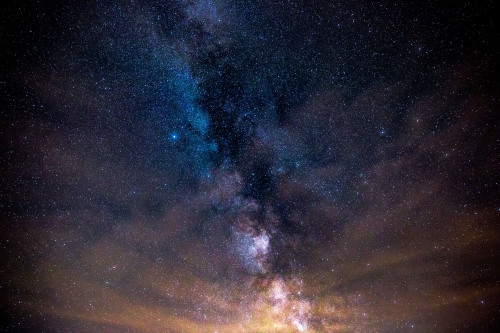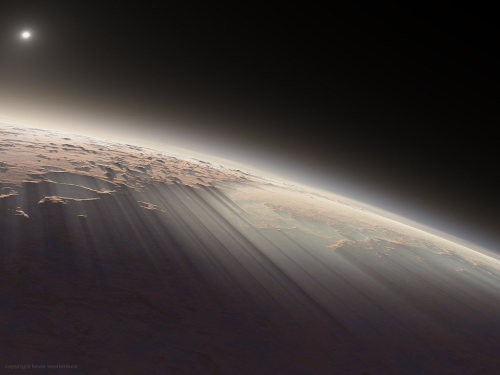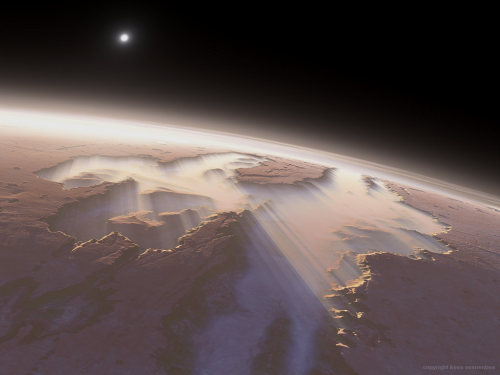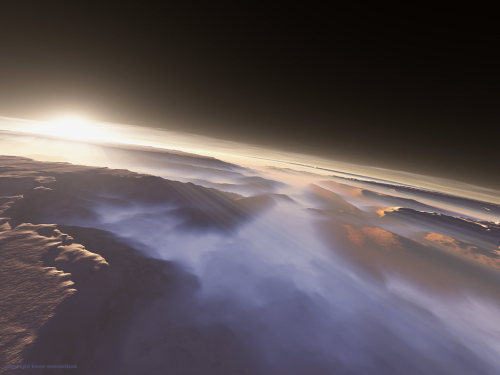These Three Bright Nebulae Are Often Featured In Telescopic Tours Of The Constellation Sagittariusand

These three bright nebulae are often featured in telescopic tours of the constellation Sagittariusand the crowded starfields of the central Milky Way.
In fact, 18th century cosmic touristCharles Messier cataloged two of them; M8, the large nebula left of center, and colorful M20 near the bottom of the frame. The third, NGC 6559, is right of M8, separated from the larger nebula by dark dust lanes. All three are stellar nurseries about five thousand light-years or so distant. The expansive M8, over a hundred light-years across, is also known as the Lagoon Nebula. M20’s popular moniker is the Trifid.
In the composite image, narrowband data records ionized hydrogen, oxygen, and sulfur atoms radiating at visible wavelengths. The mapping of colors and range of brightness used to compose this cosmic still life were inspired by Van Gogh’s famous Sunflowers.
Just right of the Trifid one of Messier’s open star clusters,M21, is also included on the telescopic canvas.
Object Names: M8, M20, M2, NGC 6559
Image Type: Astronomical
Credit: NASA, AndrewCampbell
Time And Space
More Posts from Littlecadet-biguniverse and Others

Milky Way js

a night with the stars will usually help
By: Jonah Reenders

The California Nebula.


Mercury is passing directly across the sun for the first time in nearly a decade.
The innermost planet of our solar system will look like a small, dark circle cutting across the sun’s disc. In the U.S., the transit began shortly after 7 a.m. ET on Monday and will continue for more than seven hours.
At least part of the transit, which only happens about 13 times every century, will be visible across the Americas, Europe, Africa and large portions of Asia.
If you’re hoping to watch it, eye protection is key. NASA stresses that “viewing this event safely requires a telescope or high-powered binoculars fitted with solar filters made of specially-coated glass or Mylar.”
You won’t be able to see the tiny dot of Mercury on its celestial crawl without magnification, NASA says.
Another option: Check out one of the multiple live-streaming events going on Monday. NASA says it will stream the transit here, here and here.
It’s not all about the show — transits like this one have historically been, and continue to be, important research opportunities for scientists. First observed in 1631, the transits were later used to “measure the distance between the Earth and the Sun,”NASA said.
Now, they provide scientists an opportunity to study the planets’ exospheres — the thin layer of gases that make up their atmosphere.
“When Mercury is in front of the sun, we can study the exosphere close to the planet,” NASA scientist Rosemary Killen said in a release from the Jet Propulsion Laboratory. “Sodium in the exosphere absorbs and re-emits a yellow-orange color from sunlight, and by measuring that absorption, we can learn about the density of gas there.”
Additionally, scientists have found that a transiting planet causes a drop in the sun’s brightness.
This phenomenon is “the main way we find planets outside the solar system,” NASA says.
The Kepler mission, which is searching for habitable planets, has found 1,041 planets to date using the transit method. The mission says it is able to determine the size of a planet by observing its transit.
Image Credit: NASA






Morning On Mars
Martian sunrises, as seen by the HiRISE orbiter

The most color rich region of night sky, the Milky Way Core and Rho Ophiuchi Complex
js

Carina Nebula clouds. So stunning.

M7: Open Star Cluster in Scorpius : M7 is one of the most prominent open clusters of stars on the sky. The cluster, dominated by bright blue stars, can be seen with the naked eye in a dark sky in the tail of the constellation of the Scorpion . M7 contains about 100 stars in total, is about 200 million years old, spans 25 light-years across, and lies about 1000 light-years away. The featured wide-angle image was taken near the city of Belo Horizonte in Brazil. The M7 star cluster has been known since ancient times, being noted by Ptolemy in the year 130 AD. Also visible are a dark dust cloud on the lower right, and, in the background, literally millions of unrelated stars towards the Galactic center. via NASA
js

Hubbles Variable Nebula
js
-
 ammon-rah liked this · 5 years ago
ammon-rah liked this · 5 years ago -
 azorasshai liked this · 5 years ago
azorasshai liked this · 5 years ago -
 anxiety-prone-human liked this · 6 years ago
anxiety-prone-human liked this · 6 years ago -
 canigetsomecoffee-blog liked this · 7 years ago
canigetsomecoffee-blog liked this · 7 years ago -
 nlockett reblogged this · 7 years ago
nlockett reblogged this · 7 years ago -
 nlockett liked this · 7 years ago
nlockett liked this · 7 years ago -
 thebentwookie reblogged this · 8 years ago
thebentwookie reblogged this · 8 years ago -
 andwildisthewind-blog1 liked this · 8 years ago
andwildisthewind-blog1 liked this · 8 years ago -
 illulinn liked this · 8 years ago
illulinn liked this · 8 years ago -
 comet-crazy-blog reblogged this · 8 years ago
comet-crazy-blog reblogged this · 8 years ago -
 evenstwink-blog reblogged this · 8 years ago
evenstwink-blog reblogged this · 8 years ago -
 sevocanx-blog liked this · 8 years ago
sevocanx-blog liked this · 8 years ago -
 yinofyang liked this · 8 years ago
yinofyang liked this · 8 years ago -
 shynoun18-blog liked this · 8 years ago
shynoun18-blog liked this · 8 years ago -
 academysoftware-blog1 liked this · 8 years ago
academysoftware-blog1 liked this · 8 years ago -
 after-moonrise liked this · 8 years ago
after-moonrise liked this · 8 years ago -
 bluelectricblu liked this · 8 years ago
bluelectricblu liked this · 8 years ago -
 dasbuchundderhut reblogged this · 8 years ago
dasbuchundderhut reblogged this · 8 years ago -
 xxkattanaxx reblogged this · 8 years ago
xxkattanaxx reblogged this · 8 years ago -
 foxfiregalaxy liked this · 8 years ago
foxfiregalaxy liked this · 8 years ago -
 gaymanreality reblogged this · 8 years ago
gaymanreality reblogged this · 8 years ago -
 smileexists1d liked this · 8 years ago
smileexists1d liked this · 8 years ago -
 pattiromo liked this · 8 years ago
pattiromo liked this · 8 years ago -
 scrollypoly liked this · 8 years ago
scrollypoly liked this · 8 years ago -
 courtneyxthorne liked this · 8 years ago
courtneyxthorne liked this · 8 years ago -
 girl-and-anime-freak liked this · 8 years ago
girl-and-anime-freak liked this · 8 years ago -
 heyitsholliday liked this · 8 years ago
heyitsholliday liked this · 8 years ago -
 castiellexx-blog liked this · 8 years ago
castiellexx-blog liked this · 8 years ago -
 musthavebeenhigh reblogged this · 8 years ago
musthavebeenhigh reblogged this · 8 years ago -
 futuehoe liked this · 8 years ago
futuehoe liked this · 8 years ago -
 littlecadet-biguniverse reblogged this · 8 years ago
littlecadet-biguniverse reblogged this · 8 years ago -
 ostentatiousrrex liked this · 8 years ago
ostentatiousrrex liked this · 8 years ago -
 keenus-blog liked this · 8 years ago
keenus-blog liked this · 8 years ago -
 delightingintherain reblogged this · 8 years ago
delightingintherain reblogged this · 8 years ago -
 delightingintherain liked this · 8 years ago
delightingintherain liked this · 8 years ago -
 satan-took-my-picture-blog liked this · 8 years ago
satan-took-my-picture-blog liked this · 8 years ago -
 emuchipmunk reblogged this · 8 years ago
emuchipmunk reblogged this · 8 years ago -
 emuchipmunk liked this · 8 years ago
emuchipmunk liked this · 8 years ago
GREETINGS FROM EARTH! Welcome to my space blog! Let's explore the stars together!!!
144 posts